
 |
| 4.3.5 |
Importance of AntarcticaHistory, Politics, and the Future
|
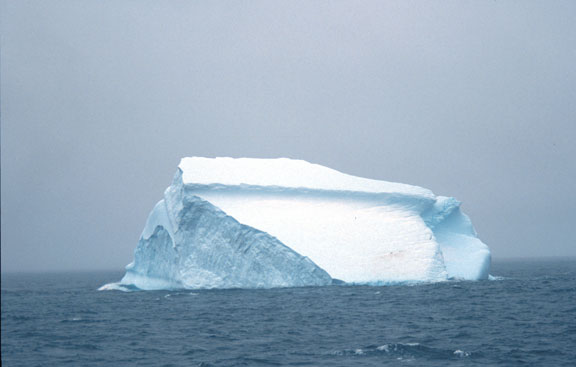 A typical Antarctic iceberg. (GA image) |
| The Arctic is often described as an ocean surrounded by land but the Antarctic is land surrounded by ocean. It is in Antarctica that the marine ecosystems dominate, the extreme seasonality of which causes many animals to migrate long distances for feeding and breeding especially noteworthy are the penguins, seals, and whales described in this presentation. But, always, ice is the dominating influence. |
| History |
| Antarctica's history of human occupation has been rather short (only since 1821). There were explorers, sealers and whalers that were the first to arrive. They explored and exploited the shorelines and nearby islands. In the early 1900s several famous expeditions set out to reach the actual South Pole. Three men are the most famous for this (Shackleton and Scott, both British, and Amundsen, a Scandinavian). Sir Ernest Shackleton's story of being beset by ice, losing his ship, and his courageous leadership and daring voyage for rescue ended with not a single loss of life. I highly recommend all versions of this event. Shackleton did not make it to the South Pole but his story is heralded as one of the greatest true adventure stories ever. Sir Robert Falcon Scott and Roald Amundsen led separate assaults on the South Pole in 1911. Amundsen's team reached the South Pole on December 14, 1911 and returned to glory. Scott's team arrived at the South Pole on January 17, 1912 only to find Amundsen's tent, a bitter disappointment. All members of Scott's team died on their return. Several accounts have chronicled this "race to the South Pole" with different approaches - all are interesting but all have the same sad ending for Scott's team. |
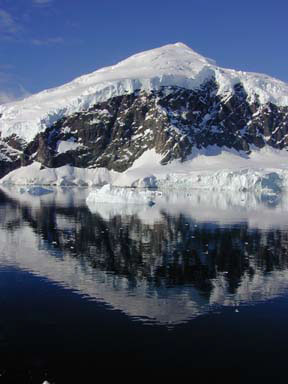 Neko Harbor, Antarctica, summer 2001. (GA image) |
| Politics |
| Antarctica is the only place on Earth that is not owned by anyone. It is now a continent of peace, environmental protection, and science. There is nowhere in the world except Antarctica where there is no military presence - it is entirely disarmed. No native peoples have inhabited Antarctica. Antarctica is a very unique continent. |
| The first country to make a claim on Antarctica was Britain, in 1908, using the sector method (areas shaped like pieces of pie, beginning with an arc of latitude and ending at a point at the pole). After this, other countries claimed areas (France, New Zealand, Norway) and Argentina and Chile claimed overlapping sectors with each other and with Britain. Conflicts began developing and the USA and Russia announced their right to claim anything in the future. In preparation for the International Geophysical Year, or IGY, (a worldwide effort to gather information about space, the poles, and the oceans) a conference was organized to coordinate Antarctic research. This called on all nations to put aside their claims, allow bases to be established for the IGY and support international cooperation. This took the heat off of the original squabbles over claims and the IGY was a successful international effort in Antarctica with many countries establishing bases and sharing resources and scientific information. When the IGY ended in 1958, Russia was one of the first countries to announce that it was not leaving Antarctica and that it would continue to keep the bases it had established. A treaty conference was held in Washington D. C. to try to resolve the conflicts and in only 18 months the Antarctic Treaty was hammered out by the original nations. |
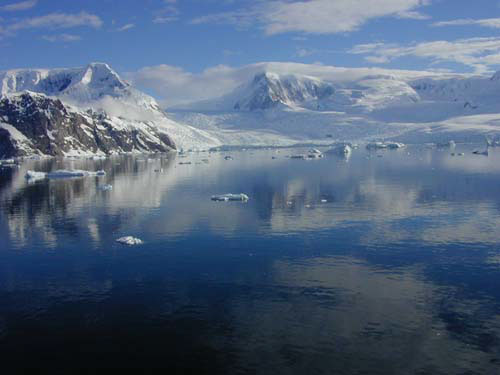 Antarctica, summer 2001, a calm sunny day. (GA image) |
| The Antarctic Treaty was ratified on June 23, 1961 and went into effect with its overall philosophy that "Antarctica shall be used for peaceful purposes only." This was a treaty started by scientists with the "rules" already worked out in the field (during the IGY) by cooperating scientists and military personnel (used as the support staff for science). The treaty did not address mining issues (a sensitive topic and one that most nations were not ready to discuss). The original treaty was designed to be "reviewed" in 30 years - but not to end. Prior to 1991 a Convention Regulating the Antarctic Minerals Resource Activities (CRAMRA) was proposed by the member nations (up to 29 in 1991) but there was disagreement and it was not ratified. There is a protocol now such that nations may not do any mining research or development in Antarctica. In 1998 a compromise agreement was reached to add a 50 year ban on mining until the year 2048. |
| Future |
| Antarctica is now hailed by many as a World Park, a continent of environmental protection and for science. The treaty is a gentlemen's agreement only, there is no governing body and no penalties for nations that step outside the boundaries of the treaty. The big challenge will come in 2048 when the mining protocol (that was a temporary agreement only) can be changed. Hopefully by then the member nations will come peacefully to an agreement. |
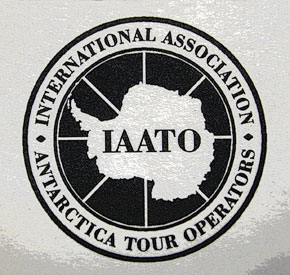 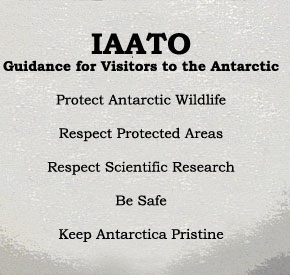 IAATO logo (left) and Guidance for Visitors (right). (GA images) |
| At this time Antarctica has become a popular destination for ecotourism. Without a governing body the tour operators (from all countries) have formed a set of rules and organized themselves as the International Association of Antarctic Tour Operators (IAATO) for the protection of the continent and safety of the tourists. These are strict guidelines and there is international agreement with their implementation. Expedition leaders in Antarctica generally talk by radio nightly during the busy summer season to exchange information about weather and animals as well as to negotiate their routes so that only one tour operator will be in each of the popular areas. This helps to reduce the impact on the environment as well as to make the tourists feel like they are the only ones "At the End of the Earth". |
(Revised 6 August 2007) |